Laser Mounts Information
 Laser mounts are devices that keep the optical components of a lens in position. There are many different types of products.
Laser mounts are devices that keep the optical components of a lens in position. There are many different types of products.
Types of Laser Mounts
Cylindrical laser mounts provide accurate laser beam placement over relatively long distances. They hold cylindrical laser heads of various sizes and provide multiple axes of precise, angular adjustment.
Twin-ring laser mounts are available in both fixed and adjustable models. They are designed for helium-neon lasers and suitable for most optical tube assemblies.
V-block base laser mounts are used to mount laser tubes and optical elements (such as achromats) that are thick enough to stand vertically on-edge. Tapped holes around the base accept clamp posts or can be used to mount the V-block.
Variable-angle diode laser mounts are also commonly available. They feature a simple tip/tilt and lock-in-place mechanism and can adjust the angle of a diode laser.
Specifications
Specifications for laser mounts vary by product type. Cylindrical laser mounts carry specifications such as:
- diameter
- the angle of tip and tilt
- the number of table holes
Parameters for twin-ring laser mounts include:
- materials of construction
- length
- weight
V-block base products differ in terms of:
- the number of tap holes
- the size of the tap holes
- the type of bar clamp assembly
Variable-angle diode laser mounts may be designed to accept 9.5 mm, 14, 8 mm, or 19.00 laser modules. Materials of construction and angular adjustment are also common specifications.
Features
In terms of features, case temperature control is suitable for applications that require tight temperature stability or different case temperatures, or for testing lasers over a relatively wide temperature range. Laser mounts with a bias-T option are also available. Specifications for these products include modulation bandwidth and impedance.
Applications
Laser mounts are used with several different types of lasers. Examples include diode lasers, solid-state lasers, helium-neon lasers, and carbon dioxide lasers. Diode lasers use light-emitting diodes to produce stimulated emissions in the form of coherent light output. They are also known as laser diodes. Solid state lasers use a transparent substance (crystalline or glass) as the active medium, doped to provide the energy states necessary for lasing. Laser mounts for these lasers are used in both low and high power applications. Helium neon (HeNe) lasers have an emission that is determined by neon atoms by virtue of a resonant transfer of excitation of helium. They operate continuously in the red, infrared, and far-infrared regions and emit highly monochromatic radiation. Carbon dioxide (CO2) lasers use the energy-state transitions between vibrational and rotational states of CO2 molecules to emit at long IR, about 10 µm, wavelengths. These lasers can maintain continuous and very high levels of power and are typically used in cutting, welding, etching, and marking applications.
Related Information
CR4 Community—Fighter Jets Get Laser Weapons (in 2023)
IEEE Spectrum—Tactical Laser Weapon Module Can Laserify Almost Anything
IEEE Spectrum—How Google's Self-Driving Car Works
Image credit:
Geek3 / CC BY-SA 4.0
